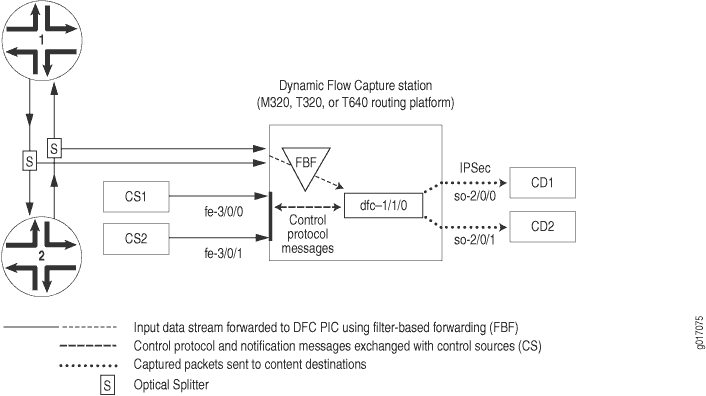Understanding Dynamic Flow Capture
Dynamic flow capture enables you to capture packet flows on the basis of dynamic filtering criteria. Specifically, you can use this feature to forward passively monitored packet flows that match a particular filter list to one or more destinations using an on-demand control protocol.
Dynamic Flow Capture Architecture
The architecture consists of one or more control sources that send requests to a Juniper Networks router to monitor incoming data, and then forward any packets that match specific filter criteria to a set of one or more content destinations. The architectural components are defined as follows:
-
Control source—A client that monitors electronic data or voice transfer over the network. The control source sends filter requests to the Juniper Networks router using the Dynamic Task Control Protocol (DTCP), specified in draft-cavuto-dtcp-03.txt at http://www.ietf.org/internet-drafts. The control source is identified by a unique identifier and an optional list of IP addresses.
-
Monitoring platform—An MX Series router containing one or more Dynamic Flow Capture (DFC) PICs, which support dynamic flow capture processing. The monitoring platform processes the requests from the control sources, creates the filters, monitors incoming data flows, and sends the matched packets to the appropriate content destinations.
-
Content destination—Recipient of the matched packets from the monitoring platform. Typically the matched packets are sent using an IP Security (IPsec) tunnel from the monitoring platform to another router connected to the content destination. The content destination and the control source can be physically located on the same host. For more information on IPsec tunnels, see Understanding Junos VPN Site Secure.
The dynamic flow capture PIC (either a Monitoring Services III PIC or Multiservices 400 PIC) forwards the entire packet content to the content destination, rather than to a content record as is done with cflowd or flow aggregation version 9 templates.
Figure 1 shows a sample topology. The number of control sources and content destinations is arbitrary.

Liberal Sequence Windowing
Each DTCP packet (add, delete, list, and refresh packets) contains a 64-bit sequence number to identify the order of the packets. Because the network is connectionless, the DTCP packets can arrive out of order to the router running the dynamic flow capture application.
The liberal sequence window feature implements a negative window for the sequence numbers received in the DTCP packets. It enables the dynamic flow capture application to accept not only DTCP packets with sequence numbers greater than those previously received, but also DTCP packets with lesser sequence numbers, up to a certain limit. This limit is the negative window size; the positive and negative window sizes are +256 and –256 respectively, relative to the current maximum sequence number received. No configuration is required to activate this feature; the window sizes are hard-coded and nonconfigurable.
Intercepting IPv6 Flows
Dynamic flow capture can intercept passively monitored IPv6 traffic only. All support for IPv4 interception remains the same. The interception of IPv6 traffic happens in the same way the filters capture IPv4 flows. With the introduction of IPv6 interception, both IPv4 and IPv6 filters can coexist. The mediation device, however, cannot be located in an IPv6 network.
Dynamic flow capture does not support interception of VPLS and MPLS traffic. The application cannot intercept Address Resolution Protocol (ARP) or other Layer 2 exception packets. The interception filter can be configured to timeout based on factors like total time (seconds), idle time (seconds), total packets or total data transmitted (bytes).
